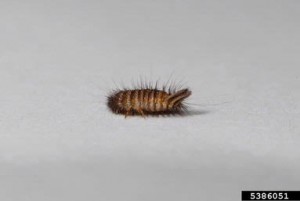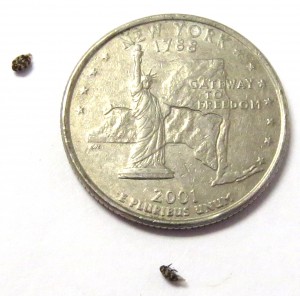After a long, cold winter it seems we skipped spring and jumped into summer! The days are growing longer and May’s flowers are in full bloom. Concurrent with this change in seasons is a programmed response of many insects to emerge from overwintering and start their annual cycle. In some cases, these insects have spent the winter inside buildings and homes, and are now trying to get out!

Overwintering insects such as the brown marmorated stink bug, boxelder bug, and ladybird beetles (ladybugs) are notorious for their emergence within homes in the spring. Meanwhile, a small colorful beetle that develops in homes year-round goes largely undetected. Dermestid beetles, such as the varied carpet beetle, develop as larvae on a tremendous variety of food sources. As pantry pests, dermestid larvae may feed on spices, grains and other dried food items. As fabric pests, they may feed on natural animal fibers such as wool, cashmere, silk and leather. As decomposers, they may feed on human and pet dander, or even dead insects and animals within the walls.

Adult dermestid beetles are much more refined in their food preferences. In the spring, adults may be observed on walls or windowsills attempting to get outside to feed on pollen from those flowers that are just starting to pop. Once they have fed and reproduced, beetles are attracted to come back indoors and lay eggs near food sources.

If you find dermestid beetles in your home, consider revisiting your spring-cleaning! Vacuum to remove dust, dander and food spillage, especially in rooms where you see beetles. Focus on those out of sight, out of mind places such as under furniture and in corners. During the summer when windows are open, make sure that screens fit snugly in the window frame and that no tears are present. This will prevent dermestid beetles from entering the home to lay eggs.
For additional information, see our What’s Bugging You? page.